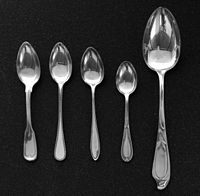Wikipedia:Spoons versus forks
This is an essay. It contains the advice or opinions of one or more Wikipedia contributors. This page is not an encyclopedia article, nor is it one of Wikipedia's policies or guidelines, as it has not been thoroughly vetted by the community. Some essays represent widespread norms; others only represent minority viewpoints. |

This essay, Spoons versus forks, describes the different concepts behind each form of pages which seem initially to be related copies of each other.
General concepts[edit]
On Wikipedia, a "spoon" is something that is similar to another but fits within the same general format, without attempting to branch into a whole new direction. For years on Wikipedia, there has been talk of "content forks" or wp:POV forks, or worries about copying a template to extend it in some new, divergent direction. However, not everything that is copied, or similar in structure, is actually a true fork. In many cases, the operation is so similar, or the design of features is so close, that those cannot properly be called "forks" but rather, are spoons which follow the same general format or purpose.
Spoons of many sizes[edit]

Even when there are multiple versions, but all using the same general format, and share the basic functionality, then all are still spoons in a set. A set of items can have many members, but all still be spoons, and none of them forks. The key concept is that a fork must branch into a major new direction, similar to the tines of a fork, where each separate tine is branching away from the common connection at the base of the fork.
In summary, a "spoon" is something that is similar to another but fits within the same general format, without attempting to branch into a whole new direction. Even though it has a smaller set of options, or runs shorter than the full version, it is still a spoon.
- [ This essay is a quick draft to be expanded later. ]
